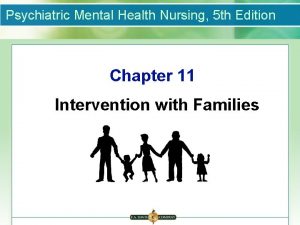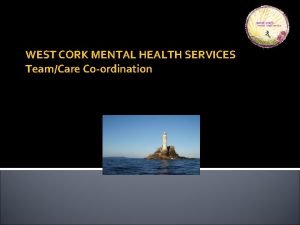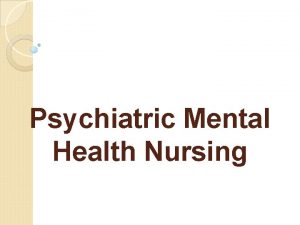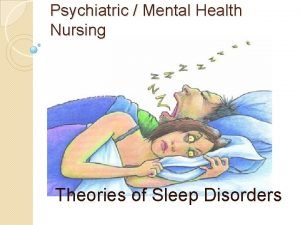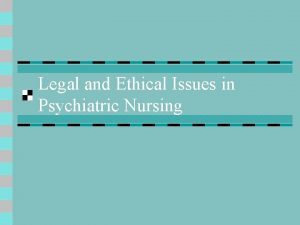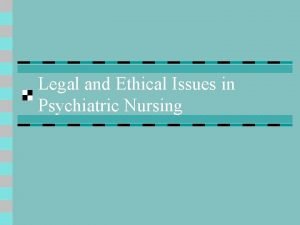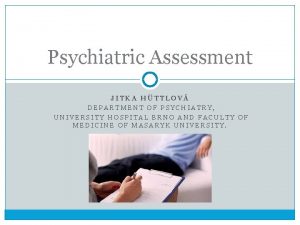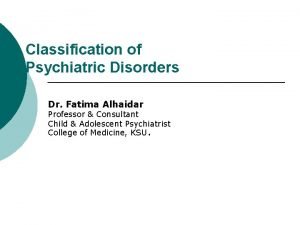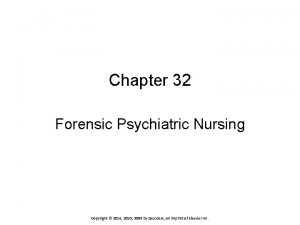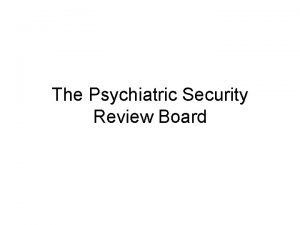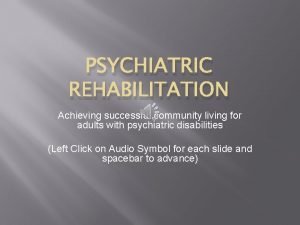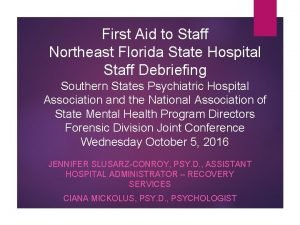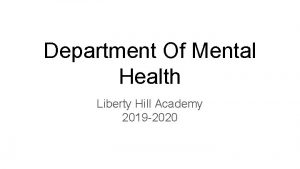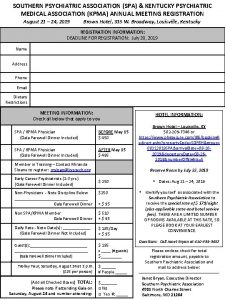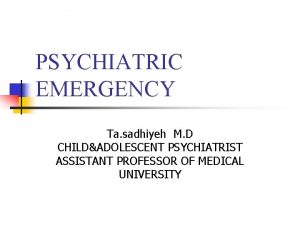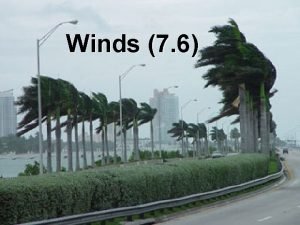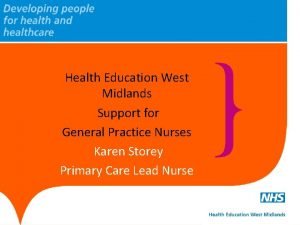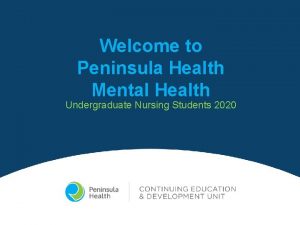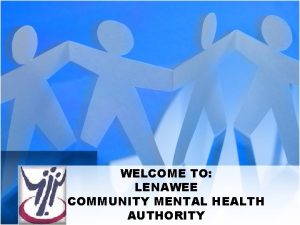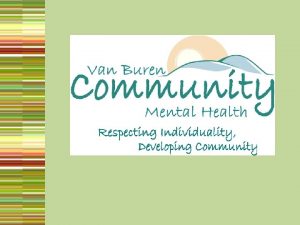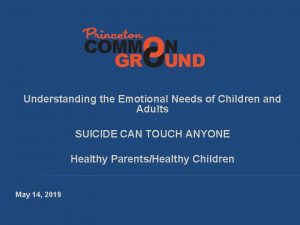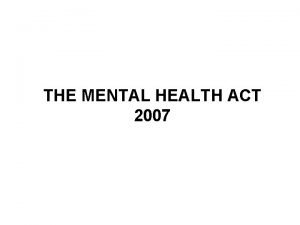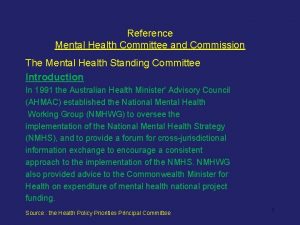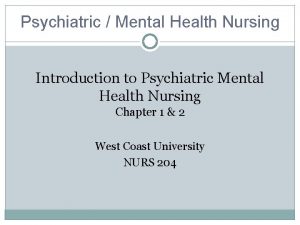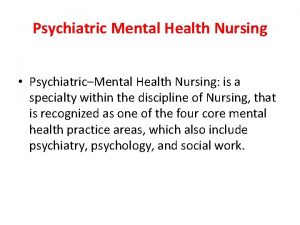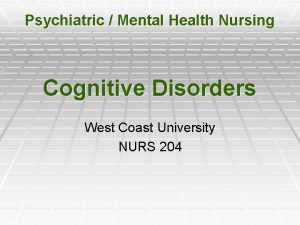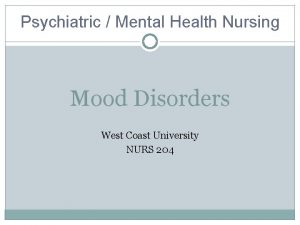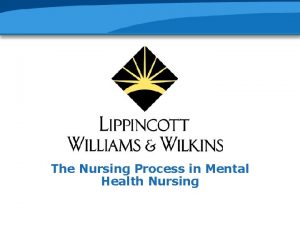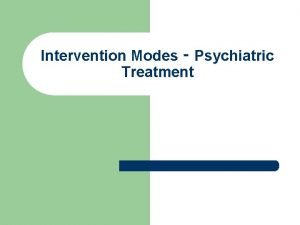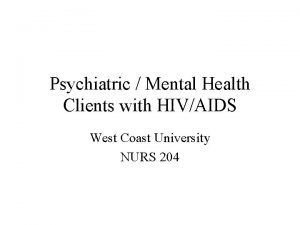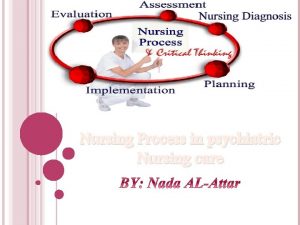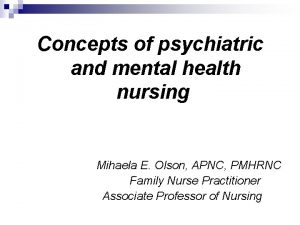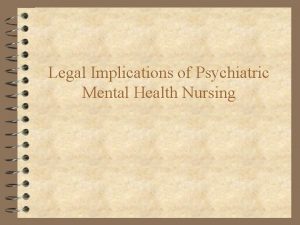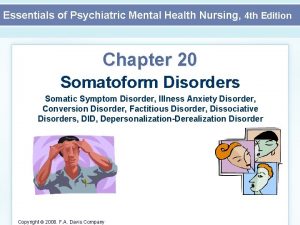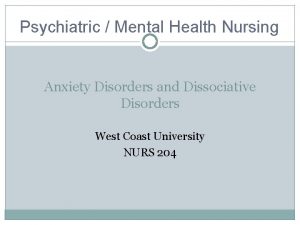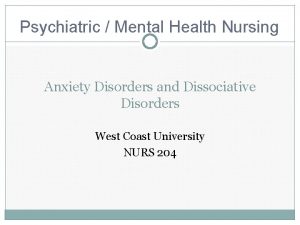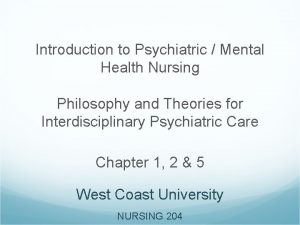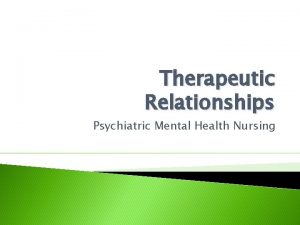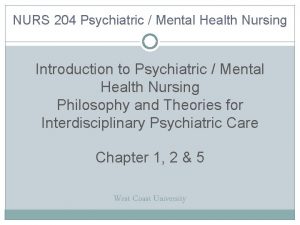The Nursing Process Psychiatric Mental Health Nursing West














































- Slides: 46

The Nursing Process Psychiatric / Mental Health Nursing West Coast University NURS 204

Standards of Care in Mental Health Nursing n n Developed by the American Nurses Association (ANA), the American Psychiatric Nurses Association, and the International Society of Psychiatric-Mental Health Nurses Delineates what professional activities the nurse performs during the steps of the nursing process as they relate to mental health nursing

Characteristics of the Nursing Process n n n Reliable, long-standing framework Cyclic/ongoing/interactive Multidimensional Adapts to client responses to health and illness Make sound clinical judgments Plan appropriate care and intervention

Steps of the Nursing Process 1. 2. 3. 4. 5. 6. Assessment Nursing Diagnosis Outcome Identification Planning Implementation Evaluation

Cyclic Nature of the Nursing Process

Nurse as Primary Communicator n Nurse is primary “tool” Identifies client strengths and problems n Requires knowledge of: n n n Psychodynamics Psychopathology Communication skills for rapport and support Client uniqueness

Collecting the Data n The interview: n n n n Gather information. Establish rapport. Structure the interview. Keep the pace comfortable. Interviewing Basics Do not rush the client in gathering the data. Respect the client’s need for minimal distractions.

Standard I. Assessment n n Mental status examination (MSE) and psychosocial assessment (Objective Data) Subjective: what the client states Objective: what is observed Findings related to: n n n Physical, sexual, psychiatric/mental status Psychosocial, developmental, cultural/spiritual factors History, Family History and physical examination (Previous diagnosis, interventions and treatments)

MSE Categories n n n n n General behavior, appearance, attitude Characteristics of speech Emotional state Content of thought Orientation Memory General intellectual level Abstract thinking Insight

General Behavior, Appearance, Attitude n n n Physical characteristics Apparent age Manner of dress Use of cosmetics Personal hygiene Responses to the examiner

General Behavior, Appearance, Attitude - continued n Also included: n n n n Posture, Gait Gestures Facial expression, Mannerisms Client’s general activity level Hygiene and dress Weight Skin color

Characteristics of Speech n n n Loudness Flow Speed Quantity Level of coherence Logic

Emotional State n n Evaluate pervasive or dominant mood or affective reaction. Pay attention to: n n n Constancy. Change. Use descriptive terms.

Orientation n n Time Place Person Self or purpose

Memory n n n Attention span Ability to retain or recall past experiences Includes both recent and remote past

General Intellectual Level n n n Nonstandardized evaluation of intelligence General grasp of information Ability to calculate Reasoning Judgment Abstract Thinking

Insight Assessment n n Recognizing the significance of the present situation Feeling the need for treatment Explaining the symptoms Making suggestions for treatment

Biologic History n n n Facts about known physical diseases and dysfunction Information about specific physical complaints General health history n n n Occupational assessment Potential exposure to toxic substances Medications the client is taking

Biologic and Neurologic Assessment n Objectives n n n Detection of underlying/unsuspected organic disease Understanding of disease as a factor in the overall psychiatric disability Appreciation of somatic symptoms that reflect psychological rather than physiologic problems

Psychological Testing: Personality n Projective personality tests n n Rorschach Test, Thematic Apperception Test, Sentence Completion Test Objective personality tests n Minnesota Multiphasic Personality Inventory– 2, State–Trait Anxiety Inventory, Millon Clinical Multiaxial Inventory–II, and Beck Depression Inventory

Psychological Testing: Cognitive Function n n Stanford-Binet Intelligence Test Wechsler Adult Intelligence Scale–III Wechsler Intelligence Scale for Children –II Raven’s Progressive Matrices Test

Special Issues Related to Assessment n n n n Managed care HIPAA privacy protection Expertise Critical thinking Settings Sources Assessment tools (e. g. , GAF scale)

Standard II. Nursing Diagnosis n Requires diagnostic reasoning n n n Analysis Synthesis Explains the health problem States the problem etiology Provides defining characteristics

NANDA Nursing Diagnoses n n n Research-based diagnoses Unique vocabulary Serves as a common language for nurses to ensure accountability for care

Actual and Potential Nursing Diagnoses n An actual problem nursing diagnosis consists of: n n Problem or need Etiology Defining characteristics A potential problem (risk) nursing diagnosis consists of: n n Risk diagnosis Risk factors as supporting factors; no etiology


DSM-IV-TR Multiaxial System n n It is evaluated on five axes, each dealing with a different class of information about the client. Multiaxial assessment is congruent with holistic views of people. It recognizes the role of environmental stress in influencing behavior. Data addresses adaptive strengths as well as symptoms or problems.

DSM-IV-TR Multiaxial System n n n Axis I: Clinical disorders Axis II: Personality disorders/mental retardation Axis III: Present medical conditions Axis IV: Psychosocial/environmental factors affecting client Axis V: Global Assessment of Functioning

Axis I: Clinical Disorders n Includes psychological factors that would affect a physical condition: n n Medication-induced movement disorders, relational problems, and others Includes conditions which may be a focus but may not constitute a clinical syndrome: n n n Marital problems Occupational problems Parent–child problems

Axis II: Personality Disorders n Contains: n n n Personality disorders diagnosed in adults Developmental disorders diagnosed in children and adolescents It is also used to report maladaptive personality traits.

Axis III: General Medical Conditions n n Physical disorders and medical conditions that must be taken into account in planning treatment They are relevant to understanding the etiology or worsening of the mental disorder.

Axis IV: Psychosocial/Environmental Factors Affecting Client n n n n Problems with primary support group Problems related to the social environment Educational problems Occupational problems Housing problems Economic problems Problems with access to health care services Problems related to interaction with the legal system/crime

Axis V: Global Assessment of Functioning – continued n Information is used to plan treatment. n n Predict outcomes n n Develop nursing diagnosis. Set goals for client behavior. Measure impact of treatment n Evaluate client response to goal/treatment.



Standard III. Outcome Identification Outcomes are: n n n Specific, measurable indicators Derived from nursing diagnoses Projections of expected influence of nursing interventions Opposite of defining characteristics Often use client’s own words

Outcomes n n Used to evaluate client’s progress May have target dates Ensure quality care Justify reimbursement Nursing Outcomes Classification (NOC) identifies outcomes most influenced by nursing actions.

Nursing Outcomes Classification n n First standardized language describing client outcomes that are most responsive to nursing care or most influenced by the actions and interventions of nurses Rated on a Likert scale (1 to 5)

Standard IV. Planning n n Collaboration with clients, significant others, and treatment team Identification of priorities of care Critical decisions regarding interventions to use Coordination and delegation of responsibilities of treatment team based on expertise as related to client’s needs

Types of Plans n n n Interdisciplinary treatment team Standardized care plans Clinical pathways, variances

Nursing Orders n Select to: n n n Achieve client outcomes Prevent/reduce problems Prescribe a course of action Focus on modifying etiology Rationales are rarely written but are often discussed in multidisciplinary team meetings.

Standard V. Implementation n n Perform nursing interventions Captures certain nursing activities and analysis of their impact on client outcomes. Promote, maintain, and restore mental and physical health NIC interventions are linked to NOC outcomes.

Standard VI. Evaluation 1. 2. 3. 4. Compare client current state/condition with outcome criteria. Consider all possible reasons why outcomes are not achieved, if this is the case. Make specific recommendations based on conclusions drawn. Continuous process of appraising the effect of nursing and the treatment regimen

Concept Mapping

Documentation n n “ 7 th Standard of Care” Problem-oriented documentation: n n n Subjective, Objective, Assessment, Planning (SOAP) Data, Analysis, Response (DAR) Behavior, Intervention, Response (BIR)

Documentation: Nursing Responsibility n n n Maintain confidentiality. Documentation: legal and clinically relevant expression of care given to the client and the client’s response to that care Respect for the client’s self-disclosures is a measure of the nurse’s trustworthiness.
 3 part nursing diagnosis examples
3 part nursing diagnosis examples Nursing process in psychiatric nursing
Nursing process in psychiatric nursing Calgary family assessment model
Calgary family assessment model West cork mental health services bantry
West cork mental health services bantry Mental health definition in nursing
Mental health definition in nursing Father of psychiatric nursing
Father of psychiatric nursing Psychiatric nursing theories
Psychiatric nursing theories Legal issues in psychiatric nursing
Legal issues in psychiatric nursing Defense mechanisms nursing
Defense mechanisms nursing Chapter 20 mental health and mental illness
Chapter 20 mental health and mental illness Mental health jeopardy
Mental health jeopardy Conclusion of community mental health nursing
Conclusion of community mental health nursing Mse in psychology
Mse in psychology Psychological disorders
Psychological disorders Cmc psychiatric hospital
Cmc psychiatric hospital Role of psychiatric nurse
Role of psychiatric nurse A behavioral crisis is most accurately defined as
A behavioral crisis is most accurately defined as Psychiatric security review board
Psychiatric security review board Psychiatric rehabilitation
Psychiatric rehabilitation American nurses association illinois
American nurses association illinois American psychiatric association annual meeting 2020
American psychiatric association annual meeting 2020 Nefsh
Nefsh Liberty hill academy
Liberty hill academy Southern psychiatric association
Southern psychiatric association Psychiatric emergencies
Psychiatric emergencies Psychiatric emergency
Psychiatric emergency Horizontal movement of air is called
Horizontal movement of air is called What creates wind
What creates wind Noorden oosten zuiden westen
Noorden oosten zuiden westen East is east and west is west
East is east and west is west Old west vs new west
Old west vs new west West yorkshire and harrogate health and care partnership
West yorkshire and harrogate health and care partnership Health education england north west
Health education england north west South west london health and care partnership
South west london health and care partnership Health education england west midlands
Health education england west midlands Unicare wv medicaid
Unicare wv medicaid Aetna better health west virginia
Aetna better health west virginia Frankston ccu
Frankston ccu Lenawee community mental health authority
Lenawee community mental health authority Van buren community mental health
Van buren community mental health The intentional use of unfriendly or offensive behavior
The intentional use of unfriendly or offensive behavior Together for mental health
Together for mental health Mental health act (2007)
Mental health act (2007) Well being triangle
Well being triangle Titles for mental health presentation
Titles for mental health presentation Mental health committee
Mental health committee Kings fund
Kings fund


